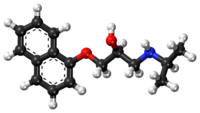
Photo from wikipedia
In this study the metabolite profiling of citalopram with the use of human liver microsomes as well as the complementary photocatalytic method were established. This strategy allowed the detection of… Click to show full abstract
In this study the metabolite profiling of citalopram with the use of human liver microsomes as well as the complementary photocatalytic method were established. This strategy allowed the detection of five metabolites of citalopram including 3-hydroxycitalopram and 3-oxocitalopram which were found as a new and not previously described metabolites of this drug The photocatalytic simulation of metabolism was carried out using tungsten (VI) oxide nanopowders with the different particle sizes, which allowed to examine the effect of this photocatalyst parameter on the mapping of metabolic processes. The accurate characterization of all observed structures was possible due to the use of ultra-high-pressure liquid chromatography and high-resolution mass spectrometry combined system as a highly useful technique in drug metabolism studies. In order to perform the toxicity prediction of citalopram and its metabolites, the acute toxicity to rodents, as well as genotoxicity, carcinogenicity, developmental toxicity and receptor-mediated toxicity was calculated basing on the in silico tools.
Journal Title: Journal of pharmaceutical and biomedical analysis
Year Published: 2020
Link to full text (if available)
Share on Social Media: Sign Up to like & get
recommendations!